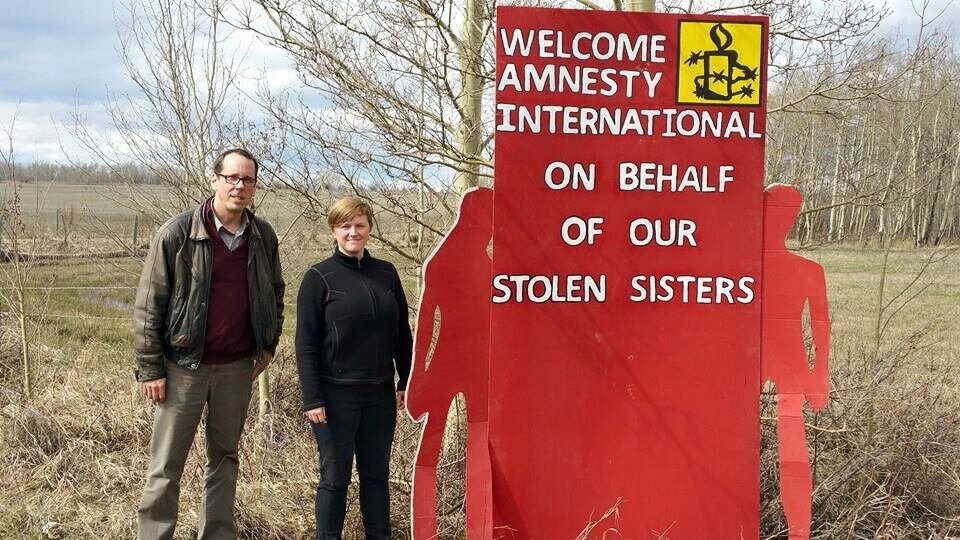How are Indigenous women affected by resource extraction?
We sat down with Amnesty International’s Campaigner for the Human Rights of Indigenous Peoples, Craig Benjamin, to find out.

In February 2016, Amnesty International released a report on Indigenous women’s experiences with energy development in Northeast British Columbia. Called Out of Sight, Out of Mind, the report points out the direct and indirect impacts of resource extraction on Indigenous women. From increased rates of domestic violence and sexual assault to food insecurity and lack of affordable housing: these are impacts that we don’t hear about a lot, but they make women much more vulnerable.
I spoke with Craig Benjamin, Amnesty’s campaigner for the human rights of Indigenous peoples and co-author of the report, to find out what’s been missing from the public discourse around resource extraction in B.C.
Q&A with Craig Benjamin
Emma Jones: What motivated this report?
Craig Benjamin: This report grew out of ongoing work, for almost a decade, around issues of violence against Indigenous women and girls. We’ve reached a point in Canada where there’s finally recognition of the horrendously disproportionate rates of violence facing Indigenous women. But it became apparent to us that some of the most important decisions affecting the lives of Indigenous women, their families and communities were being made without any consideration of whether that decision would increase Indigenous women’s vulnerability, would put them in harm’s way. And here, we’re talking about decisions about resource development.
What did you find? Do influxes of temporary workers increase risks to women’s lives?
There’s no doubt that some people who come to work on these projects are good neighbours for the communities that they join. But when you bring thousands, and tens of thousands, of people into an area that has a relatively low population, you’re going to create new pressures. You’re going to create pressures on housing, you’re going to create pressure on the basic cost of living. And when the prices rise, women are particularly disadvantaged.
What we’ve seen in northern B.C. is one of the largest income gaps between women and men in the country. While resource development brings high-paying jobs for some, it also puts the cost of living outside the reach of those who typically don’t have access to those jobs.
When you have housing insecurity, when you have food insecurity, these are always red flags for potential increases in violence against women. And what we heard in Fort St. John, over and over again, were terrible stories about the choices women were forced to make: stay with an abusive partner or be homeless? Because without access to a partner’s income, there was no way to secure safe housing for a woman and her family.
Was there anything that you found that you weren’t expecting to?
The thing that was really the most disturbing was that all the indications, all the things that should have been red flags, had been talked about and documented for decades.
We had years upon years of Indigenous community members speaking out about the strains their communities were under. We had years upon years of government studies and academic studies, saying that the burden of hosting such a large part of the province’s resource industry was leading to things like problems with alcohol and drug abuse, patterns of violence in the home and community associated with this economy. And yet, time and again, decisions would get made to approve a project, get the go-ahead to mining or pipeline expansion or the Site C dam, without taking a good look at what the implications would be for women in general in the community, and particularly for Indigenous women.
What’s the missing link between having the research and actually publicly recognizing this issue?
I think, broadly, when we look at the issue of violence against Indigenous women and girls, the deep frustration felt by activists, affected families, community members and Indigenous women’s organizations has always been translating the knowledge of the violence into real action. And a big part of the issue is that the acknowledgment doesn’t equal prioritization.
Government and the general public can look at the high rates of violence against Indigenous women, express sympathy, but still not make changing our policies, our actions, a real priority. And I think it still comes down to the fact that the lives of Indigenous women and girls simply aren’t valued as much as others.
What’s one thing all Canadians should be talking about?
Unless you involve the people whose lives are affected, then you’re not going to understand the true nature of the impact. You’re not going to be able to ensure that you’ve minimized harm, and also, you’re going to be unable to maximize benefits. The participation of Indigenous people in decisions will sometimes mean that Indigenous people say: ‘No, a certain project shouldn’t go forward.’
But we would also see many instances where Indigenous people can use their experience, their knowledge of local needs, to improve a project, to reduce the potential harms and ensure that the benefits are shared in their own communities in a sustainable way.
This interview is part of an ongoing investigation into the human impacts of resource extraction in British Columbia and Alberta. It has been edited for length and clarity.
